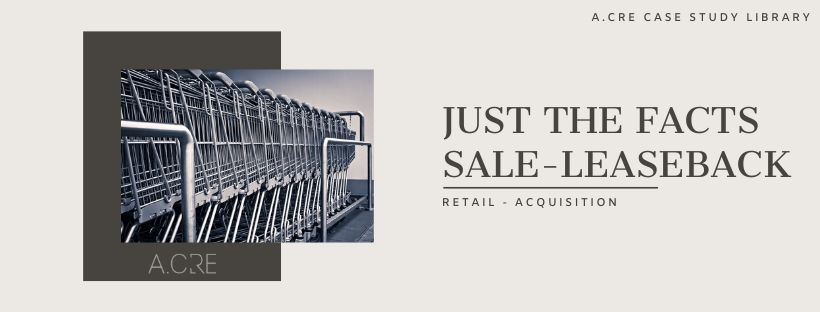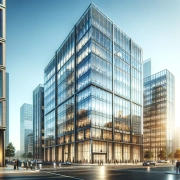Case Study #3 – Just the Facts – Retail Sale-Leaseback – Case Only (Updated May 2024)
This is the third in a series of commercial real estate case studies shared by A.CRE. These case studies are meant to help you practice to master real estate financial modeling. Just the Facts puts you in the role of a direct real estate investor analyzing the feasibility of purchasing a retail sale-leaseback from a regional big box tenant.
Practice makes perfect!
Each case study shared in this series mirrors real world situations, either in terms of the types of deals you will look at in various roles or the types of modeling tests you’ll be required to perform as part of the interview process. You can browse this and other case studies in the A.CRE Library of Real Estate Case Studies.
Are you an Accelerator Advanced member? Download this case study for free and discuss possible solutions with other Accelerator members in the Career Advancement Endorsement. Not yet an Accelerator member? Consider enrolling today in the Accelerator, the industry’s go-to real estate financial modeling training program used by top companies and elite universities to train the next generation of CRE professionals.
Case Study Introduction
For this retail sale-leaseback, you have been presented with the off-market opportunity to personally purchase a 40,000 SF, single-tenant retail store leased to Best Box, a regional leader in consumer electronics and appliances. You are a personal friend of the Best Box CEO, and she recently approached you about purchasing their flagship store.
Upon selling the store, Best Box would leaseback the property from you on a 20-year lease with 5% rent increases every five years. The proposed rent is $25/SF/Yr NNN.
You’ve been working hard the last few years at A.CRE Development and have banked several six-figure promotes. Those earnings have been sitting in a high-yield savings account, awaiting the right opportunity. This could be a great opportunity to put those funds to work for 5-10 years at a yield substantially better than your savings account.
Before making a decision, you decide to analyze the investment. You open up an Excel workbook and begin to model the cash flows.
Assumptions – Just the Facts – Retail Sale-Leaseback
- RSF is 40,000.
- Income is $25 / RSF growing 5% every five years.
- Reimbursable expenses are $5 / RSF growing 1.5% per year.
- Asking cap rate is 6.25% on year 1 NOI.
- Disposition cap rate at the end of a 5-year hold period is 6.50%.
- The investment is financed by a loan at 70% LTV, 3.25% rate, and a 30-year amortization period.
Questions
- What is the asking price amount?
- What is the unlevered IRR?
- What is the levered IRR?
- What is the year 3 free and clear return?
- What is the year 3 cash on cash return?
Extra Credit – Equity Capitalization
You approach your cousin about contributing 75% of the required equity. Your cousin is interested subject to understanding what his equity returns would be. You offer to split all cash flow pari passu and pro rata based on ownership share, but ask for a 1% acquisition fee, a 1% disposition fee, and a 0.50% of AUM annual asset management fee.
- What is your levered IRR, net of fees?
- What is your friend’s levered IRR, net of fees?
CREATE YOUR OWN CASE STUDY
This case study offers a view of the strategic decisions involved in a real estate retail sale-leaseback purchase. As you apply the provided data and strategies in your financial models, you’ll gain insights into optimizing asset value and ensuring investment criteria are met, key skills for any CRE professional. For those looking to deepen their expertise, our Real Estate Case Study Creator provides a platform to test and enhance your modeling skills in a controlled, realistic setting.
This GPT creates completely custom real estate case studies from scratch and allows users to craft case studies to simulate scenarios they are interested in or expect to encounter in their professional lives. This customization allows users to focus on particular areas of interest or challenge, making the practice sessions as relevant and effective as possible.
Additionally, after completing this Case Study #3 – Just the Facts – Retail Sale-Leaseback, you can use the Real Estate Case Study Creator GPT to analyze your results and provide an assessment of your strategies and outcomes. We encourage both seasoned practitioners and newcomers to use this resource to refine their approach and decision-making in commercial real estate investments.
- Note: Custom GPTs are now available to both paid and free users of ChatGPT. Click here to learn more.
Frequently Asked Questions about Case Study #3 – Just the Facts – Retail Sale-Leaseback
What is the asking price for the property?
The asking price is based on a 6.25% cap rate applied to Year 1 NOI. With rent at $25/SF for 40,000 SF, Year 1 NOI is $1,000,000. Dividing $1,000,000 by 6.25% yields an asking price of $16,000,000.
How do I calculate the unlevered IRR for this deal?
The unlevered IRR is calculated using the full purchase price ($16M) and projecting annual cash flows from NOI and the final sale proceeds (based on a 6.5% cap on Year 5 NOI). Cash flows include annual rent (with 5% bumps every 5 years) and a sale in Year 5.
How do I compute the levered IRR?
To calculate the levered IRR, subtract loan proceeds from the purchase price to determine equity investment. Use annual cash flows after debt service and include sale proceeds minus remaining loan balance at exit to calculate IRR on equity.
What is the Year 3 free and clear return?
The free and clear return is the Year 3 NOI divided by the original purchase price. With NOI steady in early years, Year 3 free and clear return is likely to be around 6.25%, consistent with the entry cap rate.
How is Year 3 cash-on-cash return determined?
It is calculated as Year 3 cash flow after debt service divided by the equity invested. This requires using the loan terms (70% LTV, 3.25% rate, 30-year amortization) to determine debt service and subtracting that from NOI.
What are my returns if I bring in a capital partner?
With your cousin contributing 75% of the equity and you charging a 1% acquisition fee, 1% disposition fee, and 0.5% AUM annually, your levered IRR net of fees will increase slightly due to fee income. Your cousin’s net IRR will decrease slightly due to the fees but will still reflect their 75% pro-rata share of deal performance.
Why is this case study useful for real estate professionals?
It simulates a realistic investment scenario requiring underwriting skills, DCF modeling, debt structuring, and equity waterfall considerations. It mirrors tasks CRE professionals face during actual transactions or interview modeling tests.
What tools are provided to help complete the case?
You receive the case prompt and can use any A.CRE Excel financial modeling tools or your own models. Accelerator Advanced members get free downloads and peer discussion for deeper analysis and learning.









